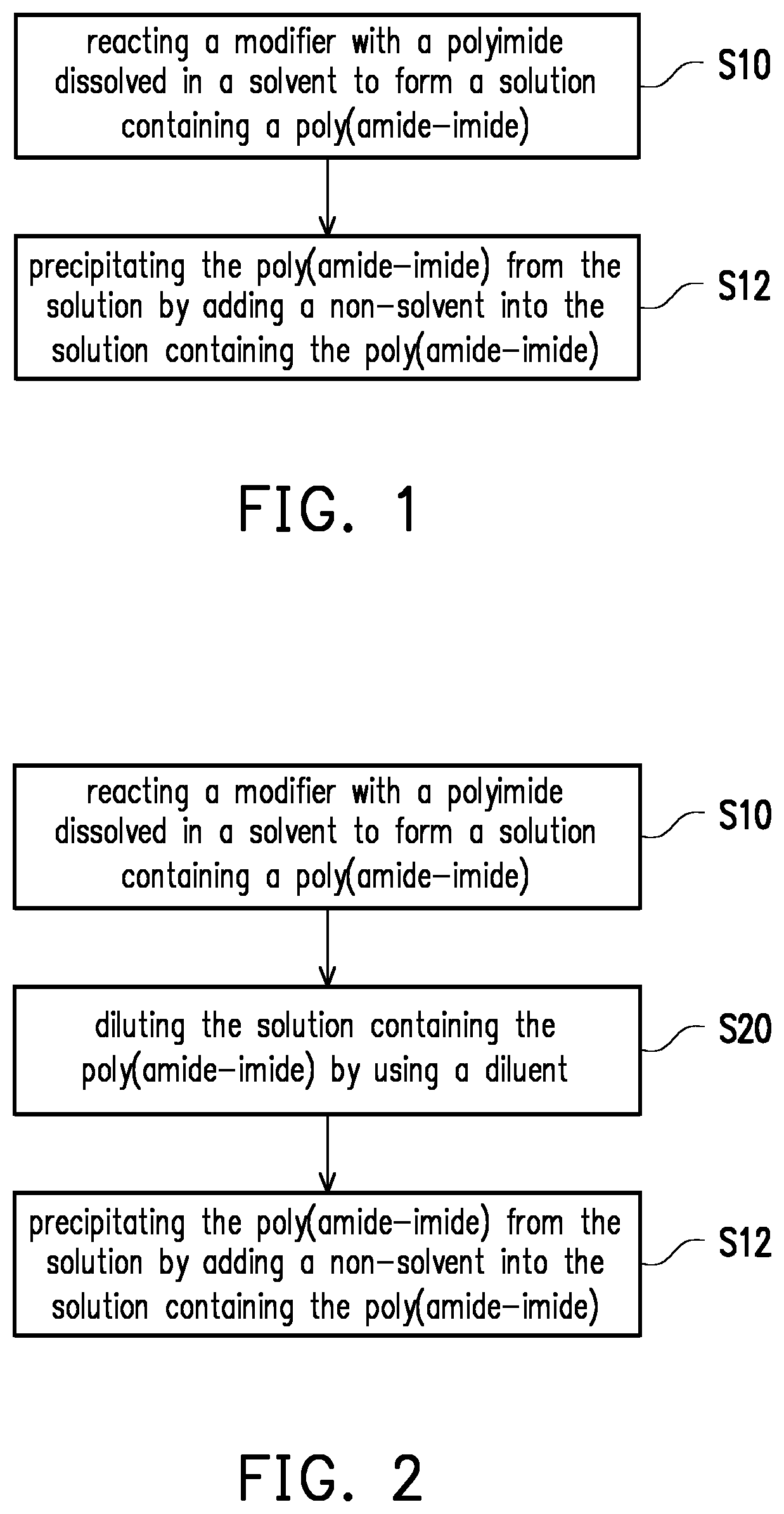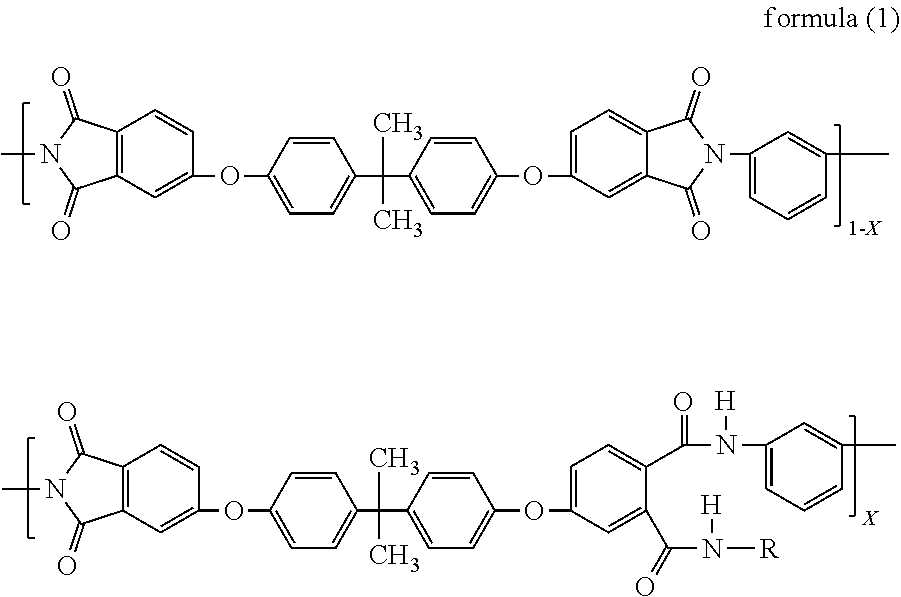Poly(amide-imide) and method of preparing the same
a technology of polyamideimide and amide, which is applied in the field of polyamideimide and a preparation method, can solve the problems of limited use of engineering plastics, difficult to achieve for a general machine, and high possibility of generation of hydrofluoric acid with strong corrosive properties, and achieve good melt processability and reduce melt processing temperature
- Summary
- Abstract
- Description
- Claims
- Application Information
AI Technical Summary
Benefits of technology
Problems solved by technology
Method used
Image
Examples
example 1
[0047]First, 100 parts by weight of polyimide (manufactured by Sabic, trade name: ULTEM 1010 PEI) was dissolved in a solvent DMAc to form a 25 wt % polyimide solution. Next, 5 parts by weight of a modifier aniline was added to the polyimide solution, and the reaction of the modifier aniline and the polyimide was carried out at 80° C. for 6 hours to form a solution containing the poly(amide-imide) of Example 1, wherein a molar ratio of the polyimide and the modifier aniline was 1:25.7, and the solution containing the poly(amide-imide) of Example 1 had a viscosity of about 10,000 cps. Subsequently, the solution containing the poly(amide-imide) of Example 1 was diluted with a diluent DMAc to form a diluted solution containing the poly(amide-imide) of Example 1 and having a viscosity of about 100 cps. Next, 2 liters (or an excess amount) of non-solvent methanol was added to the diluted solution to precipitate the poly(amide-imide) of Example 1. It is worth noting that the precipitated p...
example 2
[0048]First, 100 parts by weight of polyimide (manufactured by Sabic, trade name: ULTEM 1010 PEI) was dissolved in a solvent DMAc to form a 25 wt % polyimide solution. Next, 1.5 parts by weight of a modifier phenylmethylamine was added to the polyimide solution, and the reaction of the modifier phenylmethylamine and the polyimide was carried out at 80° C. for 6 hours to form a solution containing the poly(amide-imide) of Example 2, wherein the molar ratio of the polyimide to the modifier phenylmethylamine was 1:6.7, and a viscosity of the solution containing the poly(amide-imide) of Example 2 was about 7,300 cps. Subsequently, the solution containing the poly(amide-imide) of Example 2 was diluted with a diluent DMAc to form a diluted solution containing the poly(amide-imide) of Example 2 and having a viscosity of about 100 cps. Thereafter, 2 liters (or an excess amount) of non-solvent methanol was added to the diluted solution to precipitate the poly(amide-imide) of Example 2. It is...
example 3
[0049]First, 100 parts by weight of polyimide (manufactured by Sabic, trade name: ULTEM 1010 PEI) was dissolved in a solvent DMAc to form a 25 wt % polyimide solution. Next, 2 parts by weight of a modifier phenylmethylamine was added to the polyimide solution, and the reaction of the modifier phenylmethylamine and the polyimide was carried out at 80° C. for 6 hours to form a solution containing the poly(amide-imide) of Example 3, wherein the molar ratio of the polyimide to the modifier phenylmethylamine was 1:8.9, and a viscosity of the solution containing the poly(amide-imide) of Example 3 was about 4,400 cps. Subsequently, the solution containing the poly(amide-imide) of Example 3 was diluted with a diluent DMAc to form a diluted solution containing the poly(amide-imide) of Example 3, wherein a viscosity of the diluted solution was about 100 cps. Thereafter, 2 liters (or an excess amount) of non-solvent methanol was added to the diluted solution to precipitate the poly(amide-imide...
PUM
| Property | Measurement | Unit |
|---|---|---|
| reaction temperature | aaaaa | aaaaa |
| reaction temperature | aaaaa | aaaaa |
| processing temperature | aaaaa | aaaaa |
Abstract
Description
Claims
Application Information
 Login to View More
Login to View More - R&D
- Intellectual Property
- Life Sciences
- Materials
- Tech Scout
- Unparalleled Data Quality
- Higher Quality Content
- 60% Fewer Hallucinations
Browse by: Latest US Patents, China's latest patents, Technical Efficacy Thesaurus, Application Domain, Technology Topic, Popular Technical Reports.
© 2025 PatSnap. All rights reserved.Legal|Privacy policy|Modern Slavery Act Transparency Statement|Sitemap|About US| Contact US: help@patsnap.com



